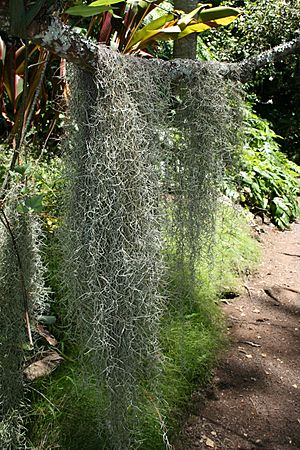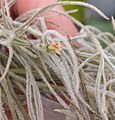Spanish moss facts for kids
Quick facts for kids Spanish moss |
|
|---|---|
 |
|
| Scientific classification | |
| Genus: |
Tillandsia
|
| Species: |
usneoides
|
| Synonyms | |
|
|
Spanish moss (Tillandsia usneoides) is a special type of plant. It grows on other plants, like trees, but it does not take food from them. This kind of plant is called an epiphyte. You can find Spanish moss in warm, wet places around the world.
It grows in Mexico, Central America, and South America. It is also found in the Southern United States and the Caribbean. In the U.S., it often hangs from southern live oak and bald cypress trees. These trees grow in swamps and wet areas.
Even though it is called "Spanish moss," it is not a real moss. It is also not from Spain. It is a flowering plant and part of the bromeliad family. This family includes plants like pineapples! In French Polynesia, people call it "grandpas beard." In Hawaii, it is sometimes called "Pele's hair."
Contents
What Spanish Moss Looks Like
Spanish moss has thin, long stems. Its leaves are also thin and often curly. They are covered in tiny scales. These hanging strands can grow up to 20 feet (6 meters) long.
The plant does not have roots that go into the ground. Its flowers are very small and hard to see. They can be brown, green, yellow, or gray.
How Spanish Moss Grows
Spanish moss gets its food and water from the air and rain. It absorbs these through its leaves. It does not hurt the trees it grows on. But if it gets too thick, it can block sunlight from the tree's leaves. This can slow down the tree's growth.
This plant likes to grow on certain trees. Southern live oaks and bald cypress trees are favorites. This is because these trees release many nutrients from their leaves. Spanish moss uses these nutrients to grow. It can also grow on other trees like sweetgum and pine trees.
Spanish moss spreads in two ways. It can grow from seeds. It also spreads when small pieces break off. These pieces can be blown by the wind onto new trees. Birds also use it to build their nests, carrying pieces to new places.
Animals That Live in Spanish Moss
Many animals use Spanish moss for shelter. Rat snakes and different kinds of bats live in it. One type of jumping spider, called Pelegrina tillandsiae, has only been found living in Spanish moss.
Some people think tiny bugs called chiggers live in Spanish moss. But studies have shown that chiggers are not usually found there.
Spanish Moss in Culture
Spanish moss is a common sight in the southern United States. It is often seen in movies and stories about the "Deep South." It gives these places a unique, mysterious look.
There is a fun story about how Spanish moss came to be. It is called "The Meanest Man Who Ever Lived." In the story, this man's long white hair got caught in the trees. It stayed there forever!
How People Use Spanish Moss
People have used Spanish moss for many things over time. In the past, it was used to stuff mattresses. It was also used as padding in car seats. In 1939, over 10,000 tons of it were used!
Today, people use it for arts and crafts. Gardeners use it as a covering for flower beds. In some places, it is used in traditional wall coverings. It is also used in Nativity scenes in Latin America and Louisiana.
In the dry areas of the southwestern U.S., dried Spanish moss is used in "swamp coolers." These are machines that cool homes. A pump puts water onto a pad made of Spanish moss. A fan then pulls air through the wet pad. As the water evaporates, it cools the air. This is a cheaper way to cool buildings than using air conditioners.
Images for kids
See also
 In Spanish: Musgo español para niños
In Spanish: Musgo español para niños




